| �It
was a victory parade � without the victory. They came in
their hundreds of thousands, joyful, singing, praying, a
great packed mass of Egypt, suburb by suburb, village by
village, waiting patiently to pass through the �people�s
security� checkpoints, draped in the Egyptian flag of red,
white and black, its governess eagle a bright gold in the
sunlight. Were there a million? Perhaps. Across the country
there certainly were. It was, we all agreed, the largest
political demonstration in the history of Egypt, the latest
heave to rid this country of its least-loved dictator. Its
only flaw was that by dusk � and who knew what the night
would bring � Hosni Mubarak was still calling himself �President�
of Egypt.�
This is how Robert Fisk of the Independent of UK captured the mood of optimism
of the peoples in Tahrir Square (also called Liberation
Square) in Cairo before the veiled fist of counter-revolution
unleashed its whip to reverse the initiative of the popular
uprising in Cairo. On Tuesday 1 February there were over
2 million people gathered on Liberation Square to demand
the removal of Hosni Mubarak, and on Wednesday 2 February
plain-clothes police and armed thugs mounted on camels and
horses stormed the unarmed citizens, attempting to kill
and brutalise those who want to be free. The people stood
their ground and beat back the government thugs.
The peoples of Egypt had grabbed the attention of the world as oppressed peoples
all over took courage from the new sense of purpose of the
Egyptians. Their confidence and freedom from fear has inspired
oppressed people in all parts of the world, and there are
already popular uprisings and protests in Jordan, Yemen
and Sudan. Not far behind are citizens in Algeria, Cameroon
and Libya who are slowly stirring and demanding political
and social change.
The peoples of Egypt and Tunisia have made their mark on the world stage and
they have shifted the balance of power back to ordinary
people. They have re-established the essence of popular
democratic participation and elevated the issues of the
politics of inclusion. This shift is bringing back the sense
of power to the exploited all over the world. Oppressed
peoples all over the world now take courage from the new
sense of purpose of the demonstrators. Their confidence
and freedom from fear have been so inspiring that there
are already popular uprisings and protests in Jordan, Yemen
and Sudan. Not far behind are citizens in Algeria, Cameroon
and Libya, who are slowly stirring and demanding political
and social change.
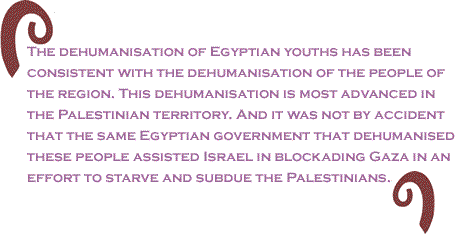
Indisputably, youths are rewriting the meaning of revolutionary organisation
and at the same time exposing the hollowness and hypocrisy
of the liberal �democratic� posture of Western imperialists.
It is this same Western liberal force that supported the
regime in Egypt as a bulwark of �stability and counter-terrorism�
in North Africa and the Middle East. By unleashing thugs
and state security personnel to attack the unarmed civilians,
the Egyptian revolution now poses a challenge of the fourth
stage of the revolution: how to harness the ideas of revolutionary
non-violence to be able to stand firm and fight back against
internal and external provocations. In this standoff, the
army will be put to the test as the external supporters
of the moribund Mubarak regime seek to crush the revolutionary
spirit of the people. One of the important tasks of the
peace and justice movements internationally is to oppose
the militarists who will seek to exploit the moment of transition
to foment war and military interventions.
MILLIONS
IN LIBERATION SQUARE AND ACROSS EGYPT
As millions of people surge on to the streets of Alexandria, Aswan, Cairo, Port
Said, Suez and other Egyptian cities, the anti-dictatorship
protest in Egypt built on the third stage of the revolutionary
process in Tunisia and brought an entirely new force, that
of the power of numbers and the test of creative means of
self defence. On Tuesday 1 February, there were reports
that an estimated 2 million people plus were on the streets
of Cairo demanding the removal of the dictatorial regime
of Mubarak. Millions more amassed in every city and community
in Egypt. In our last piece, we outlined three basic stages
of the Tunisian revolution. In our analysis we identified
the first stage as the self-immolation and sacrifice of
Mohamed Bouzazi. The second stage involved the self-mobilisation
of the popular forces of Tunis, leading to the removal of
the Ben Ali government. The third stage involved the caravans
of liberation, when people from even the most rural parts
of Tunisia rode on their caravans to Tunis to hasten the
dismantling of the remnants of the Ben Ali regime.

The massive outpouring of popular energy for social justice not only moved the
ideas of liberation from town to town but across borders.
This week, we seek to grasp how the Tunisian revolution
intersects with the Egyptian uprising, and what this means
for 21st century revolutions. In Egypt, the people have
sounded it very clearly that theirs is a popular revolt
of a revolutionary character. In both places, the potential
revolutionary character could mature to the extent that
winning the rank and file of the military and police to
create a new society could be the foundation for a quantum
leap in the changes away from dictatorship and brutal repression.
One thing that stands out in both revolutions is the search by ordinary people
and people from all walks of life to end a system that represses
their human dignity and generates fear and submission. The
Egyptian and Tunisian revolts are also uprisings against
neoliberal capitalism and the medicines of the IMF (International
Monetary Fund) and Bretton Woods institutions that pushed
the trickle-down prescription for the economic health of
society. Not only did implementing a neoliberal economic
programme supported by the IMF and World Bank in 2004�05
directly foster the income inequality and conditions which
the Tunisians and Egyptians are seeking to change, but during
this period, these same institutions �applauded� the governments
for the success of these programmes because they achieved
higher rates of GDP (gross domestic product) growth and
increased foreign investment. Just as Ireland was applauded
for its �successful� economic model before imploding, it
is evident that the �success� being achieved occurred as
impoverishment and unemployment for the majority of citizens
were increasing.
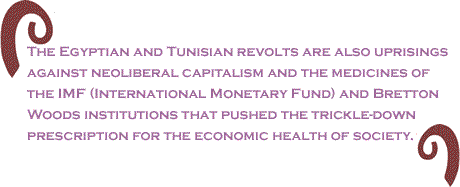
Both Tunisians and Egyptians have witnessed massive unemployment, poor living
conditions, a lack of decent housing, exploitation and low
wages, state corruption, police repression and brutality,
inflation and other forms of state terrorism. These conditions
persisted in societies of billionaires, massive expenditure
on state security apparatus and a general climate for providing
the conditions for capitalists to accumulate vast amounts
of wealth.
The dehumanisation of Egyptian youths has been consistent with the dehumanisation
of the people of the region. This dehumanisation is most
advanced in the Palestinian territory. And it was not by
accident that the same Egyptian government that dehumanised
these people assisted Israel in blockading Gaza in an effort
to starve and subdue the Palestinians.
The massive gap between the rich and the poor in Egypt is now in the open, taking
this rebellion beyond the narrative of the Western media
about rage, anger, chaos and Islamic extremism. The transformation
of the consciousness of the Egyptian and Tunisian peoples
places the issues of social transformation at the centre
of politics. Thus for the people of Egypt, it is not simply
about the removal of Mubarak, it is also about the removal
of the local and international apparatus that kept Mubarak
in power for 30 years. This understanding is important because
one narrative being told is that people are rebelling for
greater political and economic freedom, as if poverty and
unemployment were caused by the political dictators �controlling�
the economy. This is false. Under the neoliberal programmes
in Tunisia and Egypt, the economies were �liberalised� and
state-owned enterprises were �privatised� in the name of
promoting economic freedom. In such environments, political
and economic elites (foreign and local) were able to capture
the majority of whatever gains the greater economic freedoms
produced by neoliberal policies.
From the murder of Khaled Said in Alexandria last summer to the self-immolation
of the Tunisian Mohammed Bouazizi, there is a new generation
of youths who were able to mobilise social-networking tools
to light up the imagination of other youths that they had
to take a stand against police brutality. We now know that
the police beating of Khaled Said in June 2010 had �ignited
protests in Cairo and Alexandria and demands for justice
spread like wildfire on blogs and social networking sites�.
With the deployment of new social media tools of organising
by the youths and the collective security efforts of the
people to defend their communities in Egypt, there is a
pattern of self-organisation that contains the seeds of
a new strategy for 21st century revolutions. How the seeds
will germinate will depend on the extent to which the organisation
for revolutionary non-violence and self-defence can take
root to the point of beating back the organised state violence
that has been unleashed to destabilise the popular revolt.
REVOLUTIONS
WITHOUT SELF-PROCLAIMED REVOLUTIONARIES
Khaled Said had been killed because he dared to expose the depth of the corruption
of the police and the operatives of the ruling political
party, the National Democratic Party (NDP). Originally founded
by Anwar Sadat to provide legitimacy for a military dictatorship,
the NDP has dominated politics, pushing out other social
forces from the centre of the legal political stage. Mubarak
dominated this party and treated it as his personal fiefdom,
promising to place his son as the heir, as if Egypt had
become a monarchy. This example of a leader usurping the
role of the party in society undermined the meaning and
essence of political parties as vehicles of popular organisation.
A prominent feature of the revolutions in Tunisia and Egypt so far has been
the absence of vanguard parties or personalities as leaders
for the revolts. Throughout the 20th century, there was
the conception that revolutions required vanguard party
or groups comprised of the most advanced sections of the
working class and intelligentsia in the society. This vanguard
in the past had to be prepared to wage armed struggles to
capture state power. The basic thesis on the need for advanced
elements of the working class to lead revolution were spelt
out by Lenin in two important documents, �What is to be
done� and �The state and revolution�. These documents provided
a guide for revolutionaries, and there were successful revolutions
in China, Cuba and Vietnam. These revolutions were different
from the deformities of vanguardism that had developed in
the Soviet Union under Joseph Stalin and copied by Mubarak.
The negative experiences of vanguardism were not confined
to despots such as Mubarak and Stalin. Non-socialists and
non-communists in societies such as Zaire under Mobutu and
Iran practiced vanguardism. The case of Iran is of special
importance because the Mullahs adopted some of the tactics
of vanguardism with disastrous results for the people of
Iran after the overthrow of the Shah, thus undermining the
emancipatory goals of the revolutionary process. As though
the experiences of vanguardism had been studied by the young
people of Egypt and Tunisia, they were careful not to elevate
any one individual or party that could hijack or personalise
their struggle for freedom. These youths worked to build
trust and cooperation among the networks of the social forces
who were fighting for freedom.
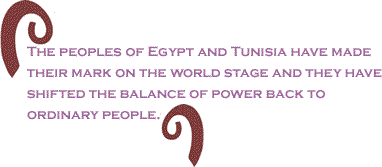
As the momentum of the Egyptian revolution gathered strength, Nobel laureate
Mohamed ElBaradei left Vienna and joined the movement, offering
himself up as a leader of the popular revolt. By the seventh
day of the popular uprising, the coalescence of the opposition
forces around ElBaradei was a defensive act because the
Western media had been insistent on placing the stamp of
Islamic extremism on this peaceful opposition to dictatorship.
These experiences make it essential to spell out the importance of revolutions
carried out without self-proclaimed revolutionaries and
leaders. In Egypt, youths and women from the April 6 movement
emerged to organise and connect the networks of networks.
It could be argued that they were aware of the positive
and negative lessons of vanguardism, whether in the former
Soviet Union or in Iran. It is for this reason that we hear
the slogan in the streets of Egypt, �this is the revolution
of all the people.�
We now know that this uprising in Egypt came after years of patient and consistent
work by young men and women who have been organising in
what is now called the April 6 Movement. This is a group
of young persons who had used the social-networking instrument
of Facebook to call on the youths of Egypt to support the
workers in their struggles. From 6 April 2008 these youths
have been meeting and organising to build a movement linking
their work to communities all across Egypt and linking up
with grassroots activists in other parts of the world. By
establishing the principles of sharing and cooperation instead
of competition, these youths of the April 6 worked to be
more effective in building a new kind of campaign for political
change.
In my book, �Barack Obama and 21st Century Politics�, I offered the principles
of Ubuntu � the philosophy of shared humanity � as a basic
revolutionary ideal for the 21st century. At the core of
this idea is the struggle to be human, and to rise above
human hierarchies, divisions and xenophobia, and compartmentalisations.
The echoes of Ubuntu reverberated from the actions of and
words of the ordinary people at the forefront of the Tunisian
and Egyptian revolutions. At some points during the protests
when Islamist sections of the protesters shouted �Allah
Akbar!�, a louder chant came, echoing �Muslims, Christians,
atheists, we are all Egyptians.� Behind these chants laid
concrete acts of Christians who offered to guard Muslims
as they prayed during the demonstrations. These small acts
of Ubuntu and recognition of each other�s humanity have
to be celebrated, elevated and cascaded across Africa and
the Middle East for transformation in the 21st century.
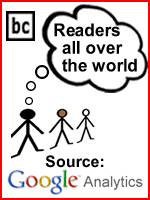 The
youths had carried forth a long tradition of struggle that
had come from the working people of Egypt. Egypt has one
of the strongest social movements for peace and justice
in Africa. Umm Kulthum is still revered in her nationalistic
songs of self-determination and dignity. Leading African
thinkers and activists from Egypt such as Samir Amin and
Nawal El Saadawi are household names among progressives
in all parts of the world. Eighty years old, Nawal El Saadawi,
in particular, spoke for millions of women, narrating how
she had been incarcerated twice � once in the cells of the
regime and then in the prison that is Egyptian society.
Her book, �Woman at Point Zero� had a statement on the call
for women in all parts of Africa and the Middle East �to
mobilise against gender oppression.� The
youths had carried forth a long tradition of struggle that
had come from the working people of Egypt. Egypt has one
of the strongest social movements for peace and justice
in Africa. Umm Kulthum is still revered in her nationalistic
songs of self-determination and dignity. Leading African
thinkers and activists from Egypt such as Samir Amin and
Nawal El Saadawi are household names among progressives
in all parts of the world. Eighty years old, Nawal El Saadawi,
in particular, spoke for millions of women, narrating how
she had been incarcerated twice � once in the cells of the
regime and then in the prison that is Egyptian society.
Her book, �Woman at Point Zero� had a statement on the call
for women in all parts of Africa and the Middle East �to
mobilise against gender oppression.�
The youths and women who have been organising day and night are the inheritors
of organising traditions that had been undertaken by trade
unionists, writer, journalists, farmers, artists, progressive
intellectuals, women, religious forces and patriotic business-persons.
The strength of these social forces is so remarkable that
the ruling elements resorted to violence. The closing-down
of the internet and shutting down of cell phone services
and non-government media were only the more modern manifestations
of a long tradition of repression that had placed conservative
militarists at the top of the political ladder in Egypt.
Anwar Sadat had been explicit in his efforts to reverse
the populist efforts of Gamal Abdel Nasser, one of the foremost
nationalists in the independence period in Africa. When
Sadat was gunned down in cold blood by elements from within
the military itself, Hosni Mubarak became president in 1981.
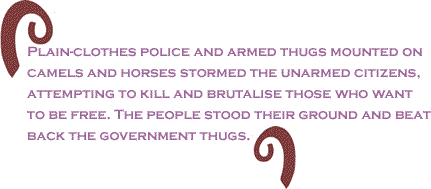
The Mubarak dictatorship was an alliance between local oppressors with US and
Israel to beat back the legitimate demands of the peoples
of Egypt. There was never a moment in the history of the
peoples of Egypt in the past century when they were not
organising and protesting for better conditions. With the
entrenchment of militaristic rule, political parties were
banned, leaders were arrested, killed or sent into exile
and genuine political expression stifled. The youths were
studying the positive and negative lessons of political
organising in order to fashion new tools for political struggle.
REVOLUTIONARY
SELF-ORGANISATION AND REVOLUTIONARY NON-VIOLENCE
All of the evidence of young men and women, rich and poor organising in communities
point to the level of social and political consciousness
that has motivated the people to mobilise themselves to
defend their interests. These millions of Egyptians are
not afraid to stand up for their rights. These people have
provided crucial revolutionary leadership and developed
tactics that have now won over the majority of the Egyptian
people to the cause of revolution. In the process, they
have broken the cohesion of the Egyptian political and economic
ruling class that had been built up with the help of the
military�industrial complex and the Wall Street elements
of the USA. It is not by accident that as the revolution
was unfolding, army chiefs from Egypt were in Washington
DC consulting with the joint chiefs of staff of the US military.
The billions of dollars that have gone from the US citizens
to support the dictatorship of Hosni Mubarak had supported
divisions in the Egyptian military so that there was a class
of officers whose interests were allied with those of the
US and Israel against the interests of the Egyptian people.
It is to this group that the sections of US and European
leaders are turning in order to break the cohesion of the
revolutionary forces in the streets. With the Western media
presenting the popular revolt as scenes of chaos and anger,
the Mubarak regime unleashed armed elements in the streets
to fit into the template of the Western image while seeking
to destroy the popular power that had occupied Tahrir Square.
When the forces of the state stormed the people on Liberation
Square the people stood their ground, defending themselves.
Hundreds were wounded but this test brought out the fourth
major stage of the revolution: the reconsolidation of the
popular forces to sharpen the tools of revolutionary non-violence
and self-defence.
These revolutionary forces in the streets have understood the social divisions
in the military and have made direct appeals to the rank
and file of the armed forces. These appeals have been consistent
with not only the tools of organising, but the manner of
organising. Having conceptualised the manner of self-organisation
in advance, the revolutionaries have been ahead of the government
so that even when the internet was shut down, the tactics
of self-organisation gave way to sophisticated and creative
means of communication. It is this sophisticated organisation
that defeated the attempts of the government to crush the
mass movement. This sophisticated organisation will also
be needed if the counter-revolutionary forces consider war
as the weapon of choice to reverse the revolution.
Indeed, the pattern of revolutionary organisation and revolutionary leadership
in the Tunisian and Egyptian revolutions have so far neutralised
the scheming of counter-revolutionary elements in Egypt
and the USA, who were bent on using anti-Islamist and counter-terrorism
propaganda to beat back the popular revolts. The centrality
of the Egyptian military to regime legitimacy in Egypt has
been consistent for the past 50 years. However, in the height
of the Cold War, the US moved to support the most conservative
fundamentalists in Egypt in order to bolster the US Cold
War goals. Younger readers may not remember that it was
in Egypt that the US recruited many of its Mujahideen fighters
to fight the Soviet Union in Afghanistan. The Mujahideen
fighters were also deployed against trade unionists, socialists,
women and other social justice networks in Egypt. Sectarianism
and fundamentalism served both the dictators and their imperial
backers.
It is imperative to note that one of the positive lessons from both Egypt and
Tunisia is the unity of the people across regional lines.
In this process, the women of Tunisia and Egypt have emerged
among the foremost and clearest section of the revolution.
For decades, Egyptian women have been struggling against
a government that suppresses Islamic fundamentalism, but
mobilized the ideas of Islamic fundamentalism to dominate
women. The images of forthright women outlining the goals
of the mass movement sweeping Egypt and Tunisia remain an
inspiration to women across Africa and the Middle East.
We want to repeat that the struggles for reproductive rights,
bodily integrity and opposition to sexual oppression elevated
the democratic struggle beyond the rights to freedom of
speech, to assemble and for workers to organise.
ITERATIONS
OF 21ST CENTURY REVOLUTIONS IN AFRICA AND THE MIDDLE EAST
The Egyptian and Tunisian revolutions have now changed the political calculus
and the discourse on politics and revolution. Not only have
these revolutions transformed the consciousness of the people,
they have also given rise to a new burst of creative energies
and become a school for new revolutionary techniques for
the 21st century. These energies could be translated into
numerous actions geared toward revolutionary transformations
across Africa and the Middle East. Clearly, the changes
in economic conditions which the people are calling for
will not be achieved by the types of reforms financed by
foreign donors to promote �more� economic freedom. They
will only be achieved by the peoples electing new leaders
and governments with the courage to implement alternative
economic policies which focus on addressing the conditions
of life as opposed to the interests of foreign investors
and local elites.

The uprising in Egypt reached a tipping point where the counter-revolutionary
forces are in disarray and cannot keep up with the pace
of change. There is a pattern of popular outpouring which
is cascading from Tunisia and Egypt to all societies under
dictatorial rule in Africa and the Middle East. The task
of the progressives is to celebrate the positive lessons
of self-organization and the wind of self-emancipation blowing
across Africa. Progressives cannot be on the sideline and
have to find their own method of showing solidarity with
the people who are now being mowed down in the streets.
We have spelt out what we are learning from some of the characteristics of these
21st revolutions. The important characteristics that we
have highlighted so far are:
1) The revolutions are made by ordinary people independent of vanguard parties
and self-proclaimed revolutionaries
2) The nature of independent networks of networks and the sophistication of
the tools of the revolution
3) The leadership of ordinary people who displayed self-mobilisation for the
revolution
4) The building of revolutionary non-violence for self-defence
5) The revolutionary ideas of the people whose ultimate goal is to be dignified
human beings and not to be dictators� robots or zealots.
It is now up to us progressives to embrace and support this pattern of revolution
to initiate a quantum leap beyond neoliberalism, capitalism,
militarism and dictatorship in Africa and the Middle East.
This commentary originally appeared in Pambazuka.

BlackCommentator.com Editorial Board Member, Dr. Horace Campbell,
PhD, is Professor of African American Studies and Political
Science at Syracuse University in Syracuse New York. He is the author of Barack Obama and Twenty-first Century Politics: A Revolutionary
Moment in the USA. Click here to contact Dr. Campbell.
|

